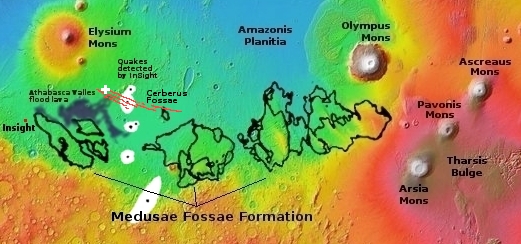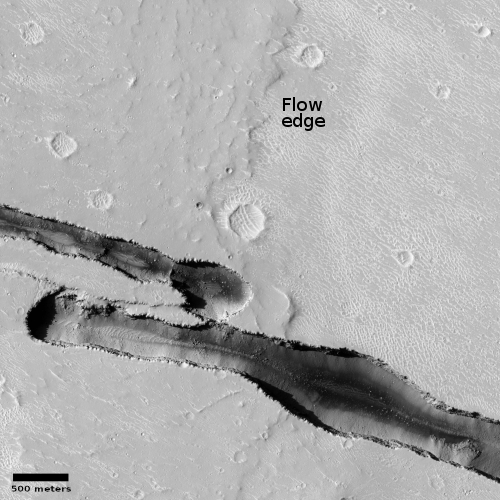New cracks across old Martian lava flows
Cool image time! The photo to the right, cropped and reduced to post here, was taken on June 4, 2021 by the high resolution camera on Mars Reconnaissance Orbiter (MRO). It captures one of the many deep straight fissure canyons that make up the feature dubbed Cerberus Fossae in the center of Mars’ volcano country.
The crack is called a graben, and happens when the ground is either stretched from pressure from below, or when two adjacent large blocks of material move sideways relative to each other.
What makes this particular graben interesting are two features. First, the overlapping break suggests something complex took place at this spot when the crack separated. Second, the crack cut across the foot of an older frozen lava flow, meaning it has to be younger than that flow.
The overview map below provides a clue when that lava flow might have occurred, while also suggesting this crack in Cerberus Fossae might be much younger than expected.

The white cross marks the location of this crack and flow, at the western end of Cerberus Fossae and just beyond the north edge of the Athabasca Valles flood lava, hypothesized by some scientists [pdf] to be the youngest large flood lava event on the Red Planet. They estimate it occurred less than 600 million years ago, covering an area about the size of Great Britain in only a matter of weeks.
This spot is also not far from another feature scientists think might be a volcanic eruption only 50,000 to 210,000 years old.
The location is also close to where InSight’s seismometer has detected its largest Earthquakes, as indicated by the white splotches on the map.
Moreover, for the cracks of Cerberus Fossae to cut across older features is not unusual. See this April 2021 cool image for just one other example.
All these facts strongly suggest that the crack itself is relatively very young. The abrupt steepness of the canyon walls as well as the sharpness of its rim further reinforces this supposition. If the fissure was old, there would have been time for the rim and canyon to soften.
This data thus suggests that some very dramatic volcanic events on Mars have happened in the relatively recent past. The underground pressure required to stretch and crack the surface as extensively as it has been in Cerberus Fossae is not trivial. More important, that there is accumulating evidence it is young means that large scale volcanism might very well still be active on Mars. Events might be well spaced out in time, but they can still occur.
On Christmas Eve 1968 three Americans became the first humans to visit another world. What they did to celebrate was unexpected and profound, and will be remembered throughout all human history. Genesis: the Story of Apollo 8, Robert Zimmerman's classic history of humanity's first journey to another world, tells that story, and it is now available as both an ebook and an audiobook, both with a foreword by Valerie Anders and a new introduction by Robert Zimmerman.
The print edition can be purchased at Amazon or from any other book seller. If you want an autographed copy the price is $60 for the hardback and $45 for the paperback, plus $8 shipping for each. Go here for purchasing details. The ebook is available everywhere for $5.99 (before discount) at amazon, or direct from my ebook publisher, ebookit. If you buy it from ebookit you don't support the big tech companies and the author gets a bigger cut much sooner.
The audiobook is also available at all these vendors, and is also free with a 30-day trial membership to Audible.
"Not simply about one mission, [Genesis] is also the history of America's quest for the moon... Zimmerman has done a masterful job of tying disparate events together into a solid account of one of America's greatest human triumphs."--San Antonio Express-News
Cool image time! The photo to the right, cropped and reduced to post here, was taken on June 4, 2021 by the high resolution camera on Mars Reconnaissance Orbiter (MRO). It captures one of the many deep straight fissure canyons that make up the feature dubbed Cerberus Fossae in the center of Mars’ volcano country.
The crack is called a graben, and happens when the ground is either stretched from pressure from below, or when two adjacent large blocks of material move sideways relative to each other.
What makes this particular graben interesting are two features. First, the overlapping break suggests something complex took place at this spot when the crack separated. Second, the crack cut across the foot of an older frozen lava flow, meaning it has to be younger than that flow.
The overview map below provides a clue when that lava flow might have occurred, while also suggesting this crack in Cerberus Fossae might be much younger than expected.

The white cross marks the location of this crack and flow, at the western end of Cerberus Fossae and just beyond the north edge of the Athabasca Valles flood lava, hypothesized by some scientists [pdf] to be the youngest large flood lava event on the Red Planet. They estimate it occurred less than 600 million years ago, covering an area about the size of Great Britain in only a matter of weeks.
This spot is also not far from another feature scientists think might be a volcanic eruption only 50,000 to 210,000 years old.
The location is also close to where InSight’s seismometer has detected its largest Earthquakes, as indicated by the white splotches on the map.
Moreover, for the cracks of Cerberus Fossae to cut across older features is not unusual. See this April 2021 cool image for just one other example.
All these facts strongly suggest that the crack itself is relatively very young. The abrupt steepness of the canyon walls as well as the sharpness of its rim further reinforces this supposition. If the fissure was old, there would have been time for the rim and canyon to soften.
This data thus suggests that some very dramatic volcanic events on Mars have happened in the relatively recent past. The underground pressure required to stretch and crack the surface as extensively as it has been in Cerberus Fossae is not trivial. More important, that there is accumulating evidence it is young means that large scale volcanism might very well still be active on Mars. Events might be well spaced out in time, but they can still occur.
On Christmas Eve 1968 three Americans became the first humans to visit another world. What they did to celebrate was unexpected and profound, and will be remembered throughout all human history. Genesis: the Story of Apollo 8, Robert Zimmerman's classic history of humanity's first journey to another world, tells that story, and it is now available as both an ebook and an audiobook, both with a foreword by Valerie Anders and a new introduction by Robert Zimmerman.
The print edition can be purchased at Amazon or from any other book seller. If you want an autographed copy the price is $60 for the hardback and $45 for the paperback, plus $8 shipping for each. Go here for purchasing details. The ebook is available everywhere for $5.99 (before discount) at amazon, or direct from my ebook publisher, ebookit. If you buy it from ebookit you don't support the big tech companies and the author gets a bigger cut much sooner.
The audiobook is also available at all these vendors, and is also free with a 30-day trial membership to Audible.
"Not simply about one mission, [Genesis] is also the history of America's quest for the moon... Zimmerman has done a masterful job of tying disparate events together into a solid account of one of America's greatest human triumphs."--San Antonio Express-News



“Overlapping” faults or graben can occur when the direction of stress is a few degrees off from a structural weakness in the rock mass (either from cooling fractures, or earlier faulting). Preferentially, the rock breaks according to those pre-existing weaknesses. But they will be overlapping, or ‘en echelon’ (geo term), conforming to the larger, regional stress field. With that said, what a spectacular view!
Greg the Geologist: Ah, thank you. That explains the overlapping cracks.
What still intrigues me is how the data is increasingly suggesting the youth of Cerberus Fossae.
Might I suggest that seismic events on Mars be referred to as “Marsquakes” or simply “quakes”? “Earthquakes” seems somehow out of place.
Andi wrote “Might I suggest that seismic events on Mars be referred to as “Marsquakes” or simply “quakes”? “Earthquakes” seems somehow out of place.”
Second.
So there is to be no common term for the geological shaking of the ground (“earth”) on which one is standing — regardless of planet? That seems dumb. And who says that the “earth” in “earthquakes” refers to the planet Earth?
I always assumed that if “Earth” was capitalized, then it referred to the specific planet. One solution, which may be confusing, is to use lower case for the generic term.